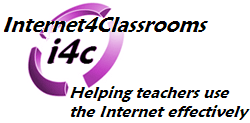

|
|
|
|
Step 1. Go to the page you want to modify. The URL for that page is: http://www.internet4classrooms.com/lesson-template.htm.Step 2. When the page has loaded, choose edit page from the File menu.
Step 3. Begin making changes to the template. This page will look very much like the template looked on Netscape. Remember that links do not work in web page development software (like Composer), and you can not edit when you are viewing the page with Communicator. The pages will look so much alike that you will forget from time to time.
Hint: Look at the toolbar. If you are in Netscape 4.7 Composer the toolbar will look like the one below:
Step 4. Editing text will be done the same way that you do it in a word processor. Highlight what you want to change and make your changes.
Step 5. Inserting images can be done by using the image button on Composer's toolbar.
- Select the image button
- Using the Image Properties dialog box, navigate to find the image
- Several other important things can be done in the above window
- If text is to be beside the image, use the Text Alignment section to specify how the text relates to the image
- If the image is to be used as a link, and you do not want that irritating blue border around the image, make sure the solid border width in the "Space around image" section has a width of 0 pixels.
- If the image is large and may take several seconds to download, you might want to put a short description of what the image will be using the Alt. Text button.
Step 6. Adding, or editing, links can be done by using the Link button on Composer's toolbar.
- Select the text to be turned into a link, or select the text which is already a link.
- Select the link button

- Paste the URL into the "Link to" portion of the Character Properties dialog box.
- You can also make a link to targets (or anchors) that are already on the web page. Select the named target and then apply.
- Targets (or anchors) can be added to your web page by using the Target button
- Targets must be added before opening the "Character Properties" dialog box
Step 6. Remember, adding, or editing, tables can NOT be done by using the Table button on Composer's toolbar. That button is used solely for creating NEW tables. If you want to edit a table, like the one on the WebQuest template, the easiest way to do that is to right-click in the table. (Mac folks, you too can right-click! Check out a tutorial on how to do that. Hint: hold down the Control key before you click, that's right-clicking for a Mac.)
Step 7. To edit the table place your cursor in a cell that you want to edit. Right-click (control+click for a mac) to see a pop-up dialog box like the one above. Using the above dialog box it is possible to insert, or delete, a row or column. If the Table Properties choice had been selected, the dialog box below would appear:
Almost anything that you could do to a table with web page development software, can be done with composer. The only thing that You can not do out of this dialog box is to change the number of rows or columns. However, that is easily done by right-clicking the table.
Step 8. To upload the page to your server, select the Publish button from Composer's toolbar.
Step 9. Give your WebQuest a Title which will be displayed in Netscape's title bar. Complete the remaining information and select "OK."
This step is not as dependable as using some other ftp application to handle uploading. For example, I used Claris HomePage to handle step 9. However, everything else about this web page was written on Composer.
Step 10. Tell everyone about your WebQuest. You are live.

Custom Search
|
Visitors since November 2000 |
Memphis, TN |
Return to Internet4Classrooms home